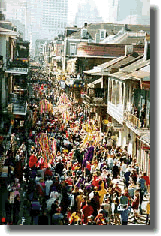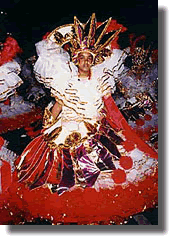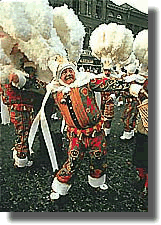

 |
 |
Carnival is celebrated with abandon
all over the world. Fancy costumes, colourful processions, festive music and
joyful dance are all part of the jubilee, with each locale adding its own twist
to the celebration.
Carnival
- Nice, France
February 10 - March 7
Dating from the 14th century, the Nice Carnival is celebrated each year during
the days leading up to Shrove Tuesday. Derived from ancient rites of spring,
the Carnival offers parades, floats, battles of flowers and confetti, and a
fireworks display lighting up the entire Baie des Anges.
This year marks the return of a popular tradition: the Grand Charivari. In the 11th century, Grand Charivari was a masked cortege that crossed the city to the sound of music. The new incarnation will give the people of Nice, street theater troupes, acrobats and visitors a chance to join in this fantastic ritual.
King Carnival is burned in effigy on a pyre at the end of the event. Many festivals throughout the United States and Europe-Pasadena's Rose Parade and Tournament, for one-have grown out of the Carnival's Battle of Flowers Parade.
Mardi Gras - New Orleans, Louisiana, USA
 February
10 - March 7
February
10 - March 7
Mardi Gras in New Orleans is known for its many parades. Donning costumes and
masks, dozens of krewes (social groups) put on individual parades, marching
on foot and aboard wildly decorated floats.
Spectators-covered in body paint and bedecked with feathers, bells, shells and ribbons--cram the streets and sidewalks along the many parade routes, shouting, "Throw me something!" In return, they are tossed strings of beads, plastic toys, knick-knacks and special coins, called doubloons.
Some of the nighttime parades still feature flambeaux (burning torches), carried by twirling figures in white robes. Another Mardi Gras tradition is the appearance of Rex, the King of Carnival, who is given reign of the city on Fat Tuesday. Mardi Gras is considered officially over at midnight, when the krewes of Rex and Comus meet, in a gesture of good will.
Carnival of Carnivals - Singapore
February
12
Singapore's 28th annual Chingay Parade introduced Western culture to Eastern
audiences through a finale called "Carnival of Carnivals." Chingay
(which means "masquerade") is often described as "the Mardi Gras
of the East," a rolling street opera of nearly 1,500 performers.
"Carnival of Carnivals," which featured more than 200 carnivaliers from 14 countries, brought together the great carnival traditions of the world-samba from Rio de Janeiro, calypso from the Caribbean, folkloric performances from Eastern Europe, mask-making from Scandinavia, sculpture from Viareggio, Italy, contemporary carnival from Australia and giant puppets and costuming from England.
Carnival - Venice, Italy
February
25 - March 7
In Venice, Carnival first gained widespread popularity in the 18th century.
The Venetian tradition of wearing masks and costumes was reportedly started
by the "stocking companies"-clubs of young Venetian noblemen intent
on amusing their fellow Venetians by organizing parties and spectacles. The
gentlemen were famous for the colorful stockings they wore.
Today, Carnival in Venice lasts two weeks. The nights beckon with masked balls and sumptuous parties, and costumed revelers crowd the narrow streets, bridges and squares, while the sounds of trumpets, firecrackers, drums and shouts fill the air. Street musicians, flame and sword-swallowers, jugglers, mimes and magicians entertain passersby on every corner.
But no matter how much fun is had, it all ends at midnight on Shrove Tuesday, when an effigy of Carnival is burned to signal the end of the festival. Everyone parades to the Piazza San Marco in their masks to see the "Concert of Ashes," which is followed by an Ash Wednesday Mass to mark the beginning of Lent.
Carnaval - Rio de Janeiro, Brazil
 March
4 - 7
March
4 - 7
Carnaval in
Rio is probably the largest of the pre-Lenten festivals. While Rio's Carnaval
is simply an enormous, fantastic spectacle it you're a tourist, for Brazilians,
it's the most important event of the year. Some locals save their money all
year to buy costumes for the grand parades.
The popularity of samba music is largely responsible for Rio's carnival success. Samba schools spend months rehearsing songs and dances, and fill Rio's Sambadrome with costumes and lyrics that reflect Brazilian history and the current political climate.
During the four days of Carnival, Rio comes alive with nighttime balls, transvestite parades, strolling samba bands and skimpily clad women (and men). The event climaxes in a frenzy of dancing, singing and exhibitionism, and has often been called, "the world's greatest party."
Lenten Carnival - Binche, Belgium
 March
5 - 7
March
5 - 7
The Lenten Carnival
of Binche is a local source of pride, with preparations beginning six weeks
before the festivities begin. The pre-carnival activities, or soumonces, include
drum and music rehearsals, as well as the "trouilles de nouilles,"
a night when costumed revelers make their way around town and attend themed
costume balls.
Carnival begins at sunrise on Shrove Sunday, when drummers take to the streets and spectators get their first glimpse of the "Mam'selles" (men in fancy dresses). Fat Tuesday is the big day for Binche, as social groups rise early to dress up as traditional carnival characters. The most notable are the gilles, whose numbers are comprised of Binche men. With tall plumed hats, jangling bells and colorful costumes stuffed with hay, the gilles are a special sight, indeed.
An evening "parade of lights" is accompanied by a brilliant display of fireworks. Binche's favorite traditions--processions, dancing, drumming and creative costumes--keep revelers celebrating this special day into the wee morning hours of Ash Wednesday.
Carnival - Port of Spain, Trinidad
March
6 - 7
In Trinidad, Carnival is a colorful, theatrical celebration of calypso music,
steel-drum bands, rum, theater and masquerade. The birthplace of calypso, Trinidad
hosts a two-day festival that boasts performances by some of the world's most
renowned performers in the genre.
In addition to musical performances, "calypso dramas" are staged: short musical skits that combine story, pantomime and songs with audience participation. Costumed participants also put on parades and parodies of famous figures.
Though it houses less than 2,000 hotel rooms each year, Trinidad hosts tens of thousands of returning natives for the great Carnival. The resulting celebratory atmosphere is infectious, and the positive energy vibrates year round.
Birmingham Carnival
August
- Carnival is about the whole community coming together to celebrate
diversity! We want everyone to get involved: from coming along on the day, to
designing a costume, to entering a competition, to sponsoring a float or a page
on this site, everyone is welcome to get involved in Carnival!
If you want to wear a costume on the day, and dance in a troupe, then contact
the legendary costume meister, Professor Black.
 |
The Birmingham Carnival Queen for 2005 Shantel Ogarro was elected as Birmingham Carnival Queen for 2005. |
Notting Hill Carnival
 August - The Notting Hill Carnival has been taking place in London,
on the last weekend in August, every year since 1964. This great festival began
initially from the energies of Black immigrants from the Caribbean, particularly
from Trinidad, where the Carnival tradition is very strong, and from people
living locally who dreamed of creating a festival to bring together the people
of Notting Hill, most of whom were facing racism, lack of working opportunities,
and poor housing conditions resulting in a general suppression of good self-esteem.
August - The Notting Hill Carnival has been taking place in London,
on the last weekend in August, every year since 1964. This great festival began
initially from the energies of Black immigrants from the Caribbean, particularly
from Trinidad, where the Carnival tradition is very strong, and from people
living locally who dreamed of creating a festival to bring together the people
of Notting Hill, most of whom were facing racism, lack of working opportunities,
and poor housing conditions resulting in a general suppression of good self-esteem.
Five disciplines
go to make up the carnival as we know it today. Mas' (masquerade), Steelband,
Calypso (political, social and satirical commentary, set to music), Soca (the
traditional music of Carnival, a fusion of Soul and Calypso) and Static Sound
Systems all play their part on the two days of Carnival-on-the-Road.
For more information click here
and here!
